Briggs & Stratton 030209-2 User Manual
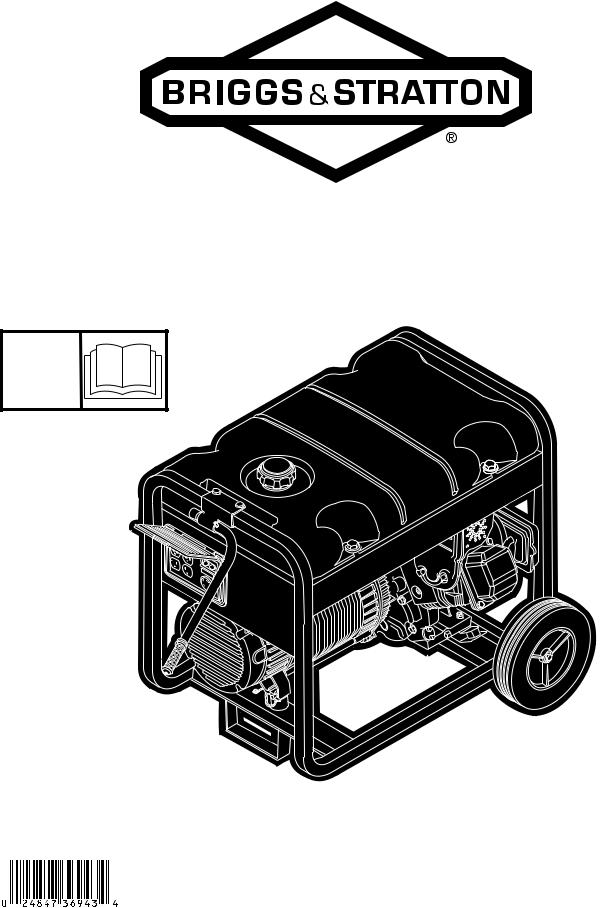
Portable Generator
Operator’s Manual
This generator is rated in accordance with CSA (Canadian Standards Association) standard C22.2 No. 100-04 (motors and generators).
BRIGGS & STRATTON POWER PRODUCTS GROUP, LLC
JEFFERSON, WISCONSIN, U.S.A.
Manual No. 199056GS Revision C (04/25/2008)

Thank you for purchasing this quality-built Briggs & Stratton generator. We are pleased that you’ve placed your confidence in the Briggs & Stratton brand. When operated and maintained according to the instructions in this manual, your Briggs & Stratton generator will provide many years of dependable service.
This manual contains safety information to make you aware of the hazards and risks associated with generators and how to avoid them. This generator is designed and intended only for supplying electrical power for operating compatible electrical lighting, appliances, tools and motor loads, and is not intended for any other purpose. It is important that you read and understand these instructions thoroughly before attempting to start or operate this equipment. Save these instructions for future reference.
This generator requires final assembly before use. Refer to the Assembly section of this manual for instructions on final assembly procedures. Follow the instructions completely.
Where to Find Us
You never have to look far to find Briggs & Stratton support and service for your generator. Consult your Yellow Pages. There are over 30,000 Briggs & Stratton authorized service dealers worldwide who provide quality service. You can also contact Briggs & Stratton Customer Service by phone at (800) 743-4115, or on the Internet at BRIGGSandSTRATTON.COM.
Generator
Model Number
Revision
Serial Number
Engine
Model Number
Type Number
Code Number
Date Purchased
Briggs & Stratton Power Products Group, LLC
900 North Parkway
Jefferson, WI 53549
Copyright © 2008 Briggs & Stratton Power Products Group, LLC. All rights reserved. No part of this material may be reproduced or transmitted in any form by any means without the express written permission of Briggs & Stratton Power Products Group, LLC.
2 |
BRIGGSandSTRATTON.COM |
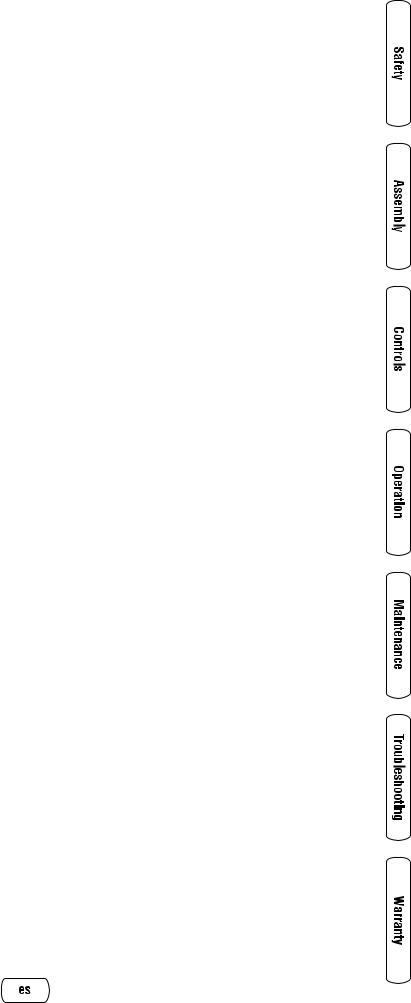
Table of Contents
Operator Safety . . . . . . . . . . . . . . . . . . . . . . . . . . . . . . . . . 4
Equipment Description. . . . . . . . . . . . . . . . . . . . . . . . . . . . . . . . . . . . . . . . . 4
Safety Rules. . . . . . . . . . . . . . . . . . . . . . . . . . . . . . . . . . . . . . . . . . . . . . . . . 4
Assembly . . . . . . . . . . . . . . . . . . . . . . . . . . . . . . . . . . . . . 7
Unpack Generator . . . . . . . . . . . . . . . . . . . . . . . . . . . . . . . . . . . . . . . . . . . . 7 Shipment Contents . . . . . . . . . . . . . . . . . . . . . . . . . . . . . . . . . . . . . . . . . . . 7 Install Wheel Kit. . . . . . . . . . . . . . . . . . . . . . . . . . . . . . . . . . . . . . . . . . . . . . 7 Add Engine Oil . . . . . . . . . . . . . . . . . . . . . . . . . . . . . . . . . . . . . . . . . . . . . . . 8 Add Fuel. . . . . . . . . . . . . . . . . . . . . . . . . . . . . . . . . . . . . . . . . . . . . . . . . . . . 8 System Ground . . . . . . . . . . . . . . . . . . . . . . . . . . . . . . . . . . . . . . . . . . . . . . 9 Connecting to a Building’s Electrical System. . . . . . . . . . . . . . . . . . . . . . . . 9 Generator Location . . . . . . . . . . . . . . . . . . . . . . . . . . . . . . . . . . . . . . . . . . . 9
Features and Controls . . . . . . . . . . . . . . . . . . . . . . . . . . . . 10
Cord Sets and Receptacles . . . . . . . . . . . . . . . . . . . . . . . . . . . . . . . . . . . . 11
Operation . . . . . . . . . . . . . . . . . . . . . . . . . . . . . . . . . . . . 12
Starting the Engine . . . . . . . . . . . . . . . . . . . . . . . . . . . . . . . . . . . . . . . . . . 12
Connecting Electrical Loads. . . . . . . . . . . . . . . . . . . . . . . . . . . . . . . . . . . . 13
Stopping the Engine. . . . . . . . . . . . . . . . . . . . . . . . . . . . . . . . . . . . . . . . . . 13
Don’t Overload Generator . . . . . . . . . . . . . . . . . . . . . . . . . . . . . . . . . . . . . 14
Maintenance . . . . . . . . . . . . . . . . . . . . . . . . . . . . . . . . . . 15
Maintenance Schedule . . . . . . . . . . . . . . . . . . . . . . . . . . . . . . . . . . . . . . . . 15
Generator Maintenance . . . . . . . . . . . . . . . . . . . . . . . . . . . . . . . . . . . . . . . 15
Engine Maintenance. . . . . . . . . . . . . . . . . . . . . . . . . . . . . . . . . . . . . . . . . . 16
Storage . . . . . . . . . . . . . . . . . . . . . . . . . . . . . . . . . . . . . . . . . . . . . . . . . . . 19
Troubleshooting . . . . . . . . . . . . . . . . . . . . . . . . . . . . . . . . 20
Warranties. . . . . . . . . . . . . . . . . . . . . . . . . . . . . . . . . . . . 21
Emissions Control System Warranty . . . . . . . . . . . . . . . . . . . . . . . . . . . . . 21
Generator Owner Warranty . . . . . . . . . . . . . . . . . . . . . . . . . . . . . . . . . . . . 23
Specifications . . . . . . . . . . . . . . . . . . . . . . . . . . . . . . . . . 24
Product Specifications . . . . . . . . . . . . . . . . . . . . . . . . . . . . . . . . . . . . . . . . 24
Common Service Parts . . . . . . . . . . . . . . . . . . . . . . . . . . . . . . . . . . . . . . . 24
Español
3

Operator Safety
Equipment Description
Read this manual carefully and become familiar with your generator. Know its applications, its limitations and any hazards involved.
The generator is an engine–driven, revolving field, alternating current (AC) generator. It was designed to supply electrical power for operating compatible electrical lighting, appliances, tools and motor loads. The generator’s revolving field is driven at about 3,600 rpm by a single-cylinder engine.
NOTICE
Exceeding generators wattage/amperage capacity can damage generator and/or electrical devices connected to it.
•DO NOT exceed the generator’s wattage/amperage capacity. See
Don’t Overload Generator in the Operation section.
Every effort has been made to ensure that the information in this manual is both accurate and current. However, the manufacturer reserves the right to change, alter or otherwise improve the generator and this documentation at any time without prior notice.
The Emission Control System for this generator is warranted for standards set by the Environmental Protection Agency and the California Air Resources Board.
Safety Rules
This is the safety alert symbol. It is used to alert you to potential personal injury hazards. Obey all safety messages that follow this symbol to avoid possible injury or death.
The safety alert symbol ( ) is used with a signal word (DANGER, WARNING, CAUTION), a pictorial and/or a safety message to alert you to hazards. DANGER indicates a hazard which, if not avoided, will result in death or serious injury. WARNING indicates a hazard which, if not avoided, could result in death or serious injury. CAUTION indicates a hazard which, if not avoided, might result in minor or moderate injury. NOTICE indicates a situation that could result in equipment damage. Follow safety messages to avoid or reduce the risk of injury or death.
) is used with a signal word (DANGER, WARNING, CAUTION), a pictorial and/or a safety message to alert you to hazards. DANGER indicates a hazard which, if not avoided, will result in death or serious injury. WARNING indicates a hazard which, if not avoided, could result in death or serious injury. CAUTION indicates a hazard which, if not avoided, might result in minor or moderate injury. NOTICE indicates a situation that could result in equipment damage. Follow safety messages to avoid or reduce the risk of injury or death.
The manufacturer cannot possibly anticipate every possible circumstance that might involve a hazard. The warnings in this manual, and the tags and decals affixed to the unit are, therefore, not all-inclusive. If you use a procedure, work method or operating technique that the manufacturer does not specifically recommend, you must satisfy yourself that it is safe for you and others. You must also make sure that the procedure, work method or operating technique that you choose does not render the generator unsafe.
Hazard Symbols and Meanings
A |
B |
C |
D |
E |
F |
G |
H |
J |
A - Explosion |
F - Hot Surface |
|
B - Fire |
G - Flying Objects |
|
C - Electric Shock |
H - Moving Parts |
|
D - Toxic Fumes |
J - Read Manual |
|
E - Kickback |
|
|
|
WARNING |
|
Running engine gives off carbon monoxide, an odorless, colorless, poison gas.
Breathing carbon monoxide can cause headache, fatigue, dizziness, vomiting, confusion, seizures, nausea, fainting or death.
•Operate generator ONLY outdoors.
•Install a battery operated carbon monoxide alarm near the bedrooms.
•Keep exhaust gas from entering a confined area through windows, doors, ventilation intakes, or other openings.
•DO NOT start or run engine indoors or in an enclosed area, (even if windows and doors are open), including the generator compartment of a recreational vehicle (RV).
4 |
BRIGGSandSTRATTON.COM |
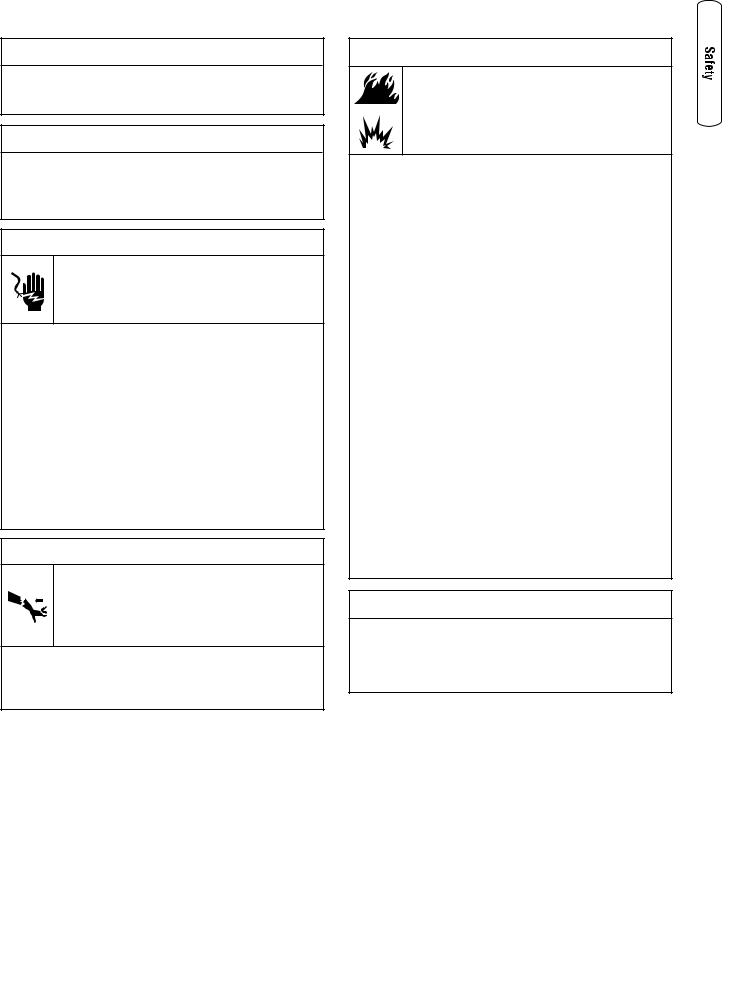
 WARNING
WARNING
The engine exhaust from this product contains chemicals known to the State of California to cause cancer, birth defects, or other reproductive harm.
 WARNING
WARNING
Certain components in this product and related accessories contain chemicals known to the State of California to cause cancer, birth defects, or other reproductive harm. Wash hands after handling.
 WARNING
WARNING
Generator produces hazardous voltage.
Failure to isolate generator from power utility can result in death or injury to electric utility workers due to backfeed of electrical energy.
•When using generator for backup power, notify utility company. Use approved transfer equipment to isolate generator from electric utility.
•Use a ground fault circuit interrupter (GFCI) in any damp or highly conductive area, such as metal decking or steel work.
•DO NOT touch bare wires or receptacles.
•DO NOT use generator with electrical cords which are worn, frayed, bare or otherwise damaged.
•DO NOT operate generator in the rain or wet weather.
•DO NOT handle generator or electrical cords while standing in water, while barefoot, or while hands or feet are wet.
•DO NOT allow unqualified persons or children to operate or service generator.
 WARNING
WARNING
Starter cord kickback (rapid retraction) can result in bodily injury. Kickback will pull hand and arm toward engine faster than you can let go.
Broken bones, fractures, bruises, or sprains could result.
•When starting engine, pull cord slowly until resistance is felt and then pull rapidly to avoid kickback.
•NEVER start or stop engine with electrical devices plugged in and turned on.
 WARNING
WARNING
 Fuel and its vapors are extremely flammable and explosive.
Fuel and its vapors are extremely flammable and explosive.
Fire or explosion can cause severe burns or death.
WHEN ADDING OR DRAINING FUEL
•Turn generator OFF and let it cool at least 2 minutes before removing fuel cap. Loosen cap slowly to relieve pressure in tank.
•Fill or drain fuel tank outdoors.
•DO NOT overfill tank. Allow space for fuel expansion.
•If fuel spills, wait until it evaporates before starting engine.
•Keep fuel away from sparks, open flames, pilot lights, heat, and other ignition sources.
•DO NOT light a cigarette or smoke.
WHEN STARTING EQUIPMENT
•Ensure spark plug, muffler, fuel cap, and air cleaner are in place.
•DO NOT crank engine with spark plug removed.
WHEN OPERATING EQUIPMENT
•DO NOT tip engine or equipment at angle which causes fuel to spill.
•This generator is not for use in mobile equipment or marine applications.
WHEN TRANSPORTING OR REPAIRING EQUIPMENT
•Transport/repair with fuel tank EMPTY or with fuel shutoff valve OFF.
•Disconnect spark plug wire.
WHEN STORING FUEL OR EQUIPMENT WITH FUEL IN TANK
•Store away from furnaces, stoves, water heaters, clothes dryers, or other appliances that have pilot light or other ignition source because they can ignite fuel vapors.
 WARNING
WARNING
•This generator does not meet U. S. Coast Guard Regulation 33CFR-183 and should not be used on marine applications.
•Failure to use the appropriate U. S. Coast Guard approved generator could result in death or serious injury and/or property damage.
5
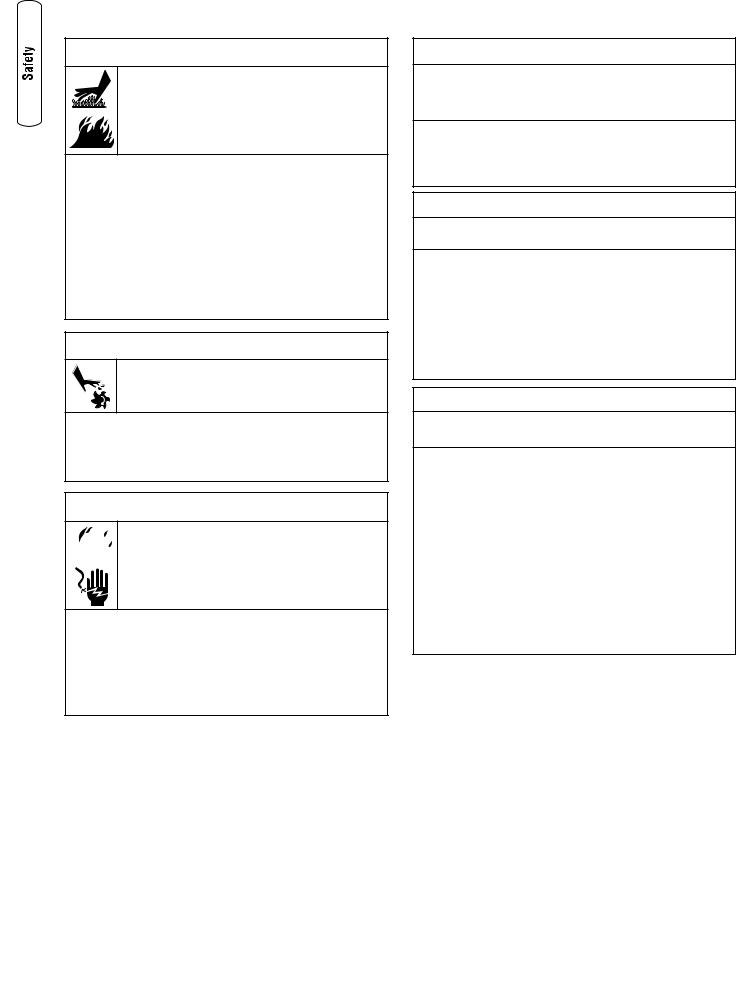
 WARNING
WARNING
Contact with muffler area can result in serious burns.
Exhaust heat/gases can ignite combustibles, structures or damage fuel tank causing a fire.
•DO NOT touch hot parts and AVOID hot exhaust gases.
•Allow equipment to cool before touching.
•Keep at least 5 feet (1.5 m) of clearance on all sides of generator including overhead.
•Code of Federal Regulation (CFR) Title 36 Parks, Forests, and Public Property require equipment powered by an internal combustion engine to have a spark arrester, maintained in effective working order, complying to USDA Forest service standard 5100-1C or later revision. In the State of California a spark arrester is required under section 4442 of the California Public resources code. Other states may have similar laws.
 WARNING
WARNING
Starter and other rotating parts can entangle hands, hair, clothing, or accessories.
•NEVER operate generator without protective housing or covers.
•DO NOT wear loose clothing, jewelry or anything that may be caught in the starter or other rotating parts.
•Tie up long hair and remove jewelry.
 WARNING
WARNING
 Unintentional sparking can result in fire or electric shock.
Unintentional sparking can result in fire or electric shock.
WHEN ADJUSTING OR MAKING REPAIRS TO YOUR GENERATOR
•Disconnect the spark plug wire from the spark plug and place the wire where it cannot contact spark plug.
WHEN TESTING FOR ENGINE SPARK
•Use approved spark plug tester.
•DO NOT check for spark with spark plug removed.
 CAUTION
CAUTION
Excessively high operating speeds increase risk of injury and damage to generator.
Excessively low speeds impose a heavy load.
•DO NOT tamper with governed speed. Generator supplies correct rated frequency and voltage when running at governed speed.
•DO NOT modify generator in any way.
NOTICE
Exceeding generators wattage/amperage capacity can damage generator and/or electrical devices connected to it.
•DO NOT exceed the generator’s wattage/amperage capacity. See
Don’t Overload Generator in the Operation section.
•Start generator and let engine stabilize before connecting electrical loads.
•Connect electrical loads in OFF position, then turn ON for operation.
•Turn electrical loads OFF and disconnect from generator before stopping generator.
NOTICE
Improper treatment of generator can damage it and shorten its life.
•Use generator only for intended uses.
•If you have questions about intended use, ask dealer or contact local service center.
•Operate generator only on level surfaces.
•DO NOT expose generator to excessive moisture, dust, dirt, or corrosive vapors.
•DO NOT insert any objects through cooling slots.
•If connected devices overheat, turn them off and disconnect them from generator.
•Shut off generator if:
-electrical output is lost;
-equipment sparks, smokes, or emits flames; -unit vibrates excessively.
6 |
BRIGGSandSTRATTON.COM |
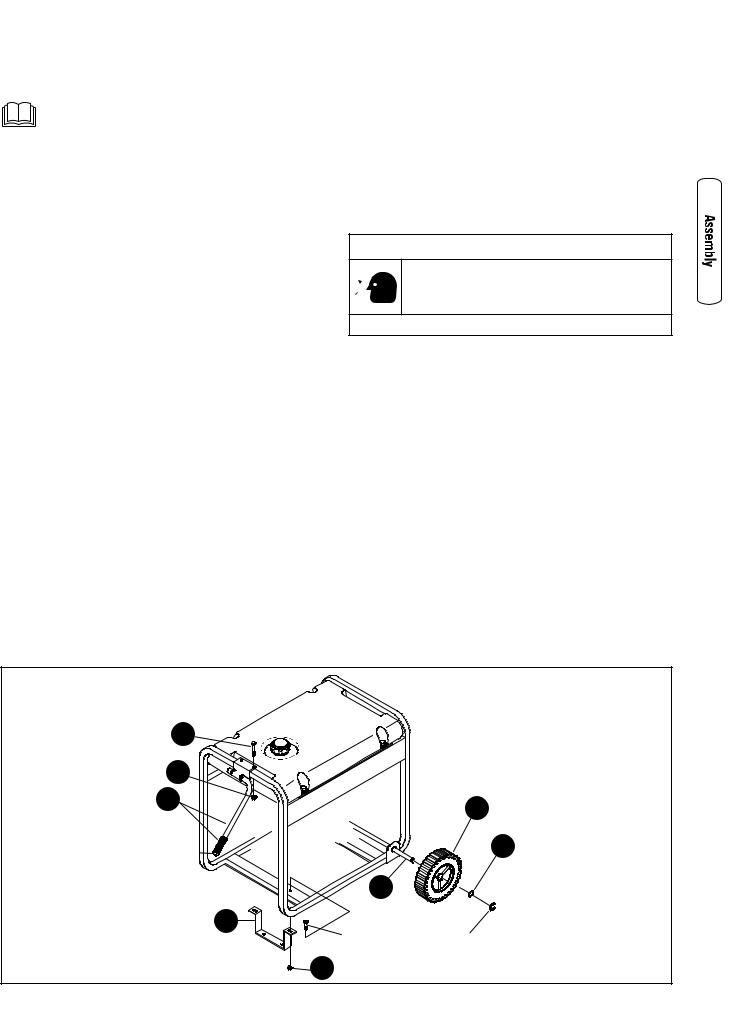
Assembly
Read entire operator’s manual before you attempt to assemble or operate your new generator.
Your generator requires some assembly and is ready for use after it has been properly serviced with the recommended fuel and oil.
If you have any problems with the assembly of your generator, please call the generator helpline at 1-800-743-4115. If calling for assistance, please have the model, revision, and serial number from the data tag available. See Generator Controls and Features for identification label location.
Unpack Generator
1.Set the carton on a rigid, flat surface.
2.Remove everything from carton except generator.
3.Open carton completely by cutting each corner from top to bottom.
4.Leave generator on carton to install wheel kit.
Shipment Contents
The generator is supplied with:
•Engine oil bottle
•Operator’s manual
•Wheel kit
Install Wheel Kit
The wheel kit is designed to greatly improve the portability of your generator.
NOTE: Wheel kit is not intended for over-the-road use. You will need the following tools to install this wheel kit:
•13mm socket wrench
•13mm open end wrench
•Pliers
•Safety glasses
Install the wheel kit as follows:
1.Tip generator so that engine end is up.
2.Slide axle (A) through both mounting brackets.
3.Slide a wheel (B) over the axle.
4.Place a washer (C) on axle and then place an e-ring (D) in axle groove.
 CAUTION
CAUTION
E-rings can cause eye injury.
 E-rings can spring back and become airborne when installing or removing.
E-rings can spring back and become airborne when installing or removing.
•Always wear eye protection when installing/removing e-rings.
5.Install e-ring with pliers, squeezing from top of e-ring to bottom of axle.
6.Repeat step 3 thru 5 to secure second wheel.
7.Tip generator so that engine side is down.
8.Attach support leg (E) using two 13mm wrenches with 25mm cap screws (F) and lock nuts (G).
9.Center lifting handle (H) on cradle. Attach handle using two 13mm wrenches with 45mm capscrews (J) and hex nuts (K).
10.Return generator to normal operating position (resting on wheels and support leg).
11.Check each fastener to ensure it is secure.
Typical Generator Shown
J
B
C
A
E
F |
|
D |
|
|
|
|
|
|
G
7
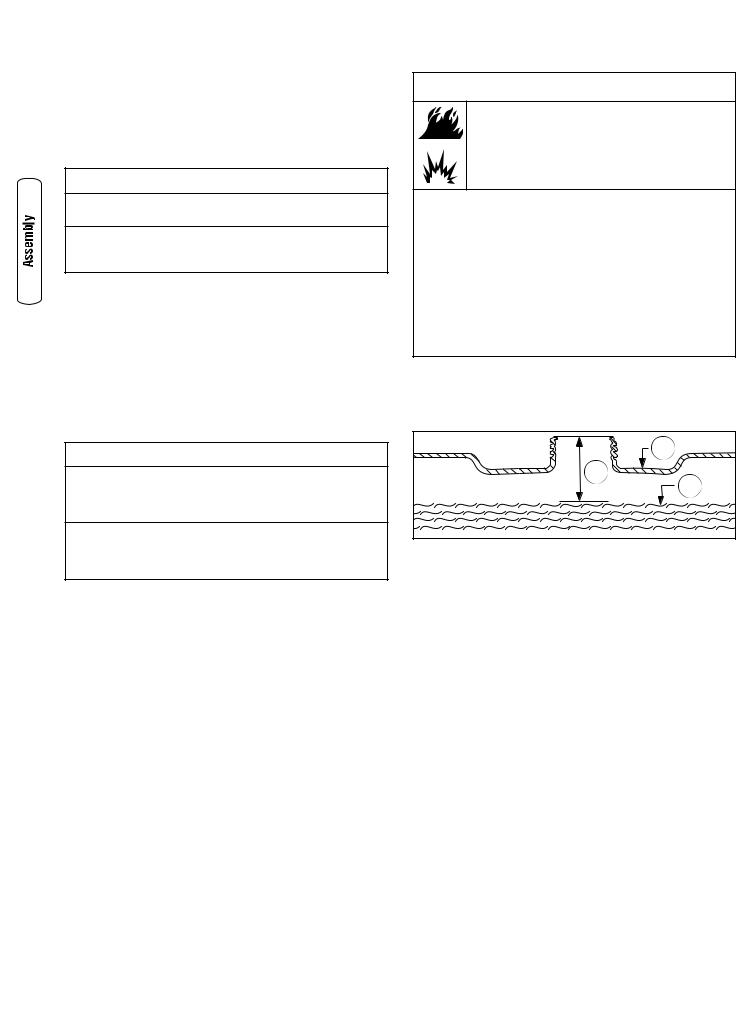
Add Engine Oil
1.Place generator on a flat, level surface.
2.Clean area around oil fill and remove yellow oil fill cap.
3.Using oil funnel (optional), slowly pour contents of provided oil bottle into oil fill opening.
NOTICE
Improper treatment of generator can damage it and shorten its life.
•DO NOT attempt to crank or start the engine before it has been properly serviced with the recommended oil. This may result in an engine failure.
4.Replace oil fill cap and fully tighten.
Add Fuel
Fuel must meet these requirements:
•Clean, fresh, unleaded gasoline.
•A minimum of 87 octane/87 AKI (91 RON). High altitude use, see High Altitude.
•Gasoline with up to 10% ethanol (gasohol) or up to 15% MTBE (methyl tertiary butyl ether) is acceptable.
NOTICE
Avoid generator damage.
Failure to follow Operator’s Manual for fuel recommendations voids warranty.
•DO NOT use unapproved gasoline such as E85.
•DO NOT mix oil in gasoline.
•DO NOT modify engine to run on alternate fuels.
To protect the fuel system from gum formation, mix in a fuel stabilizer when adding fuel. See Storage. All fuel is not the same. If you experience starting or performance problems after using fuel, switch to a different fuel provider or change brands. This engine is certified to operate on gasoline. The emission control system for this engine is EM (Engine Modifications).
 WARNING
WARNING
 Fuel and its vapors are extremely flammable and explosive.
Fuel and its vapors are extremely flammable and explosive.
Fire or explosion can cause severe burns or death.
WHEN ADDING FUEL
•Turn generator OFF and let it cool at least 2 minutes before removing fuel cap. Loosen cap slowly to relieve pressure in tank.
•Fill fuel tank outdoors.
•DO NOT overfill tank. Allow space for fuel expansion.
•If fuel spills, wait until it evaporates before starting engine.
•Keep fuel away from sparks, open flames, pilot lights, heat, and other ignition sources.
•DO NOT light a cigarette or smoke.
1.Clean area around fuel fill cap, remove cap.
2.Slowly add unleaded gasoline (A) to fuel tank (B). Be careful not to overfill. Allow about 1.5" (4 cm) of tank space (C) for fuel expansion.
B |
C |
A |
3.Install fuel cap and let any spilled fuel evaporate before starting engine.
High Altitude
At altitudes over 5,000 feet (1524 meters), a minimum 85 octane / 85 AKI (89 RON) gasoline is acceptable. To remain emissions compliant, high altitude adjustment is required. Operation without this adjustment will cause decreased performance, increased fuel consumption, and increased emissions. See an authorized Briggs & Stratton
dealer for high altitude adjustment information. Operation of the engine at altitudes below 2,500 feet (762 meters) with the high altitude kit is not recommended.
8 |
BRIGGSandSTRATTON.COM |

System Ground
The generator has a system ground that connects the generator frame components to the ground terminals on the AC output receptacles. The system ground is connected to the AC neutral wire (the neutral is bonded to the generator frame).
Special Requirements
There may be Federal or State Occupational Safety and Health Administration (OSHA) regulations, local codes, or ordinances that apply to the intended use of the generator. Please consult a qualified electrician, electrical inspector, or the local agency having jurisdiction:
•In some areas, generators are required to be registered with local utility companies.
•If the generator is used at a construction site, there may be additional regulations which must be observed.
Connecting to a Building’s Electrical System
Connections for standby power to a building’s electrical system must be made by a qualified electrician. The connection must isolate the generator power from utility power or other alternative power sources and must comply with all applicable laws and electrical codes.
 WARNING
WARNING
Generator produces hazardous voltage.
Failure to isolate generator from power utility can result in death or injury to electric utility workers due to backfeed of electrical energy.
•When using generator for backup power, notify utility company. Use approved transfer equipment to isolate generator from electric utility.
•Use a ground fault circuit interrupter (GFCI) in any damp or highly conductive area, such as metal decking or steel work.
•DO NOT touch bare wires or receptacles.
•DO NOT use generator with electrical cords which are worn, frayed, bare or otherwise damaged.
•DO NOT operate generator in the rain or wet weather.
•DO NOT handle generator or electrical cords while standing in water, while barefoot, or while hands or feet are wet.
•DO NOT allow unqualified persons or children to operate or service generator.
Generator Location
Clearances and Air Movement
 WARNING
WARNING
Exhaust heat/gases can ignite combustibles,  structures or damage fuel tank causing a fire.
structures or damage fuel tank causing a fire.
•Keep at least 5 ft. (1.5 m) clearance on all sides of generator including overhead.
Place generator outdoors in an area that will not accumulate deadly exhaust gas. DO NOT place generator where exhaust gas (A) could accumulate and enter inside or be drawn into a potentially occupied building. Ensure exhaust gas is kept away from any windows, doors, ventilation intakes, or other openings that can allow exhaust gas to collect in a confined area. Prevailing winds and air currents should be taken into consideration when positioning generator.
A |
9
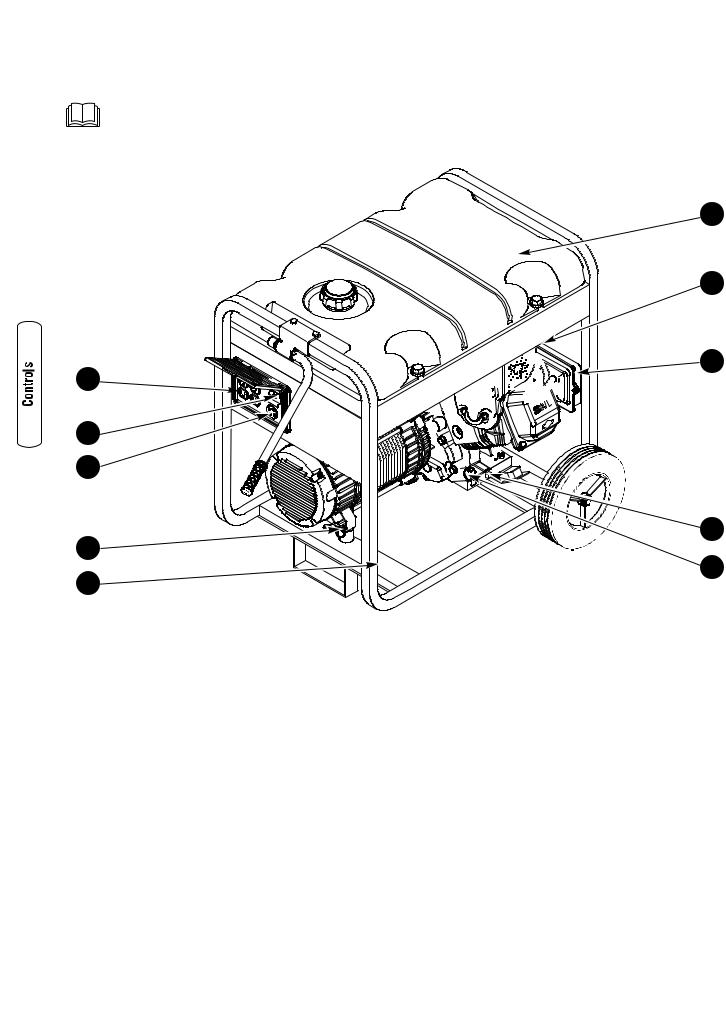
Features and Controls
Read this Operator’s Manual and safety rules before operating your generator.
Compare the illustrations with your generator, to familiarize yourself with the locations of various controls and adjustments. Save this manual for future reference.
K








 H A
H A 


AVolt AC, 20 Amp, Duplex Receptacles — May be to supply electrical power for the operation of
Volt AC, 20 Amp, single phase, 60 Hz electrical, appliance, tool, and motor loads.
B |
Breakers (AC) — Push-to-reset circuit breakers |
|
provided to protect the generator against electrical |
|
. |
C |
Volt AC, 30 Amp Locking Receptacle — May |
|
to supply electrical power for the operation of |
|
and/or 240 Volt AC, 30 Amp, single phase, 60 Hz |
|
lighting, appliance, tool and motor loads. |
DFastener — Consult your local agency having for grounding requirements in your area.
E |
Label — Provides model, revision, and |
|
serial number of generator. Please have these readily |
|
available when calling for assistance. |
F - Oil Fill Cap — Check and add engine oil here. G - Oil Drain Plug — Drain engine oil here.
H - Air Cleaner — Protects engine by filtering dust and debris out of intake air.
J - Choke Lever — Used when starting a cold engine.
K - Fuel Tank — Capacity of seven (7) U.S. gallons (26.5 L).
Items Not Shown:
Engine Identification — Provides model, type and code of engine. Please have these readily available if calling for assistance.
Recoil Starter — Used to start the engine.
Rocker Switch — Set this switch to “On” before using recoil starter. Set switch to “Off” to stop engine.
10 |
BRIGGSandSTRATTON.COM |
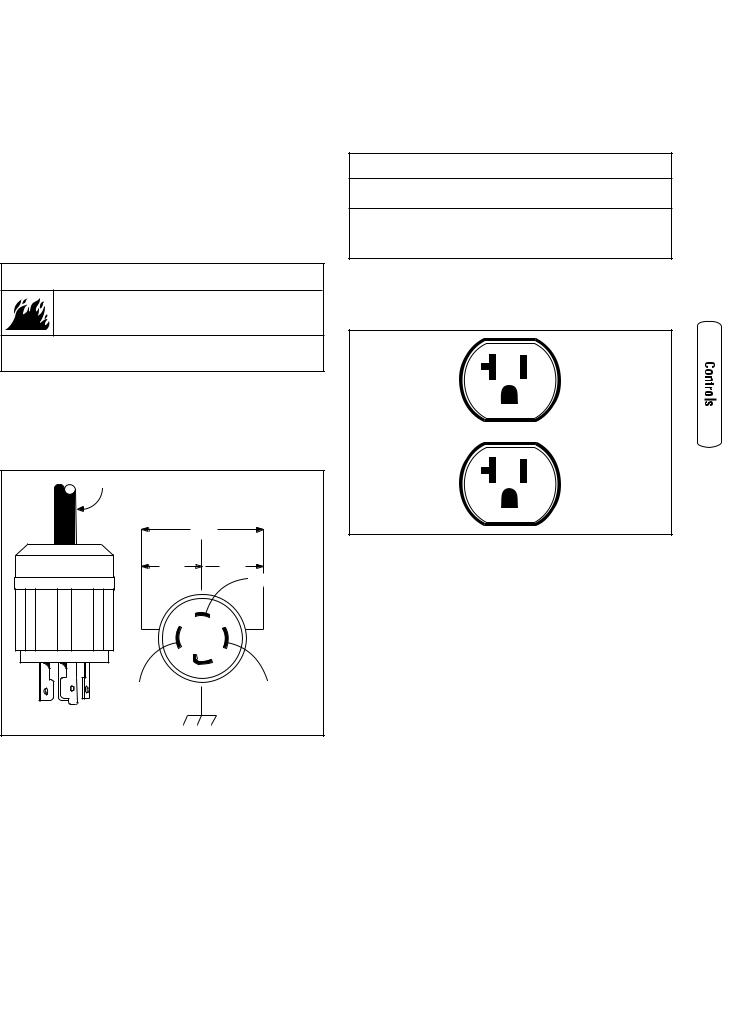
Cord Sets and Receptacles
Use only high quality, well-insulated, grounded extension cords with the generator’s 120 Volt duplex receptacle. Inspect extension cords before each use.
Check the ratings of all extension cords before you use them. Extension cord sets used should be rated for 125 Volt AC loads at 20 Amps or greater for most electrical devices. Some devices, however, may not require this type of extension cord. Check the operator’s manuals of those devices for the manufacturer’s recommendations.
Keep extension cords as short as possible to minimize voltage drop.
 WARNING
WARNING
Overloaded electrical cords can overheat, arc, and burn resulting in death, bodily injury, and/or property damage.
•ONLY use cords rated for your loads.
•Follow all safeties on electrical cords.
120/240 Volt AC, 30 Amp, Locking Receptacle
Use a NEMA L14–30 plug with this receptacle. Connect a 4–wire cord set rated for 250 Volt AC loads at 30 Amps (or greater). You can use the same 4–wire cord if you plan to run a 120 Volt load.
4-Wire Cord Set
240V
120V  120V
120V
W (Neutral)
Y (Hot) |
X (Hot) |
NEMA L14-30 |
Ground (Green) |
This receptacle powers 120/240 Volt AC, 60 Hz, single phase loads requiring up to 5,500 watts of power (5.5 kW) at
22.9 Amps for 240 Volts or two independent 120 Volt loads at 22.9 Amps each. The outlet is protected by push–to–reset circuit breakers.
NOTICE
Receptacles may be marked with rating value greater than generator output capacity.
•NEVER attempt to power a device requiring more amperage than generator or receptacle can supply.
•DO NOT overload the generator. See Don’t Overload Generator.
120 Volt AC, 20 Amp, Duplex Receptacles
Each duplex receptacle is protected against overload by a push–to–reset circuit breaker.
Use each receptacle to operate 120 Volt AC, single–phase, 60 Hz electrical loads requiring up to 2,400 watts (2.4 kW) at 20 Amps of current. Use cord sets that are rated for 125 Volt AC loads at 20 Amps (or greater).
11
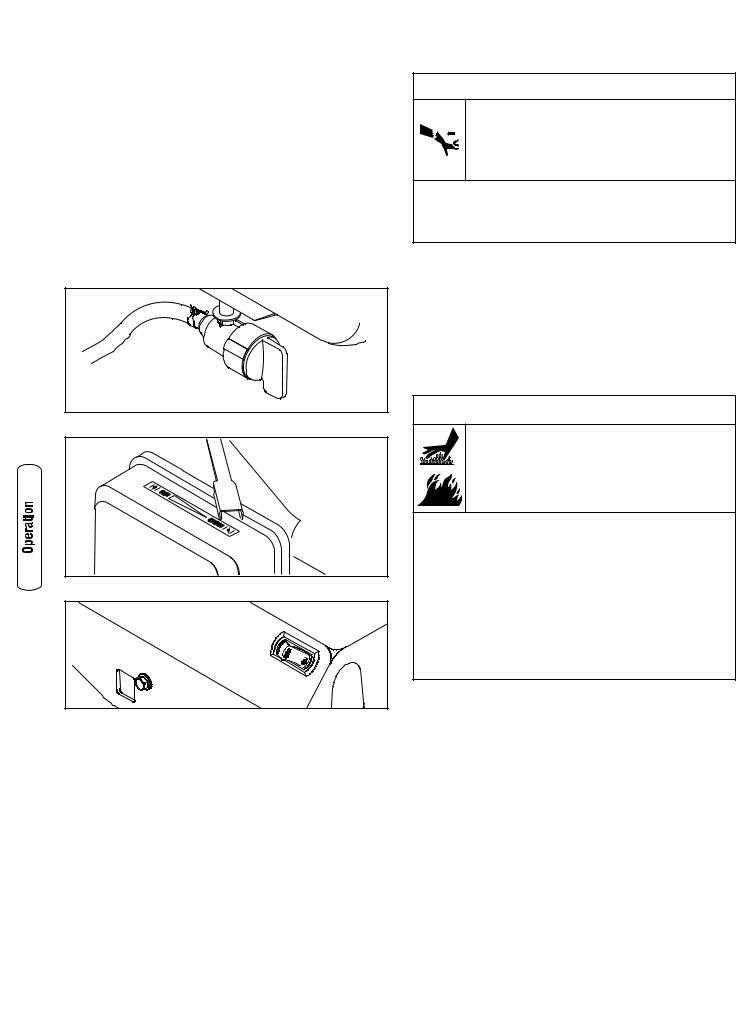
Operation
Starting the Engine
Disconnect all electrical loads from the generator. Use the following start instructions:
1. Make sure unit is on a level surface.
IMPORTANT: Failure to start and operate the unit on a level surface will cause the unit not to start or shut down during operation.
2.Turn fuel valve to “On” position. Fuel valve handle should be vertical (pointing toward ground) for fuel to flow.
3. Push choke lever to “Choke” position.
4. Push engine rocker switch to “On”.
5.Grasp recoil handle and pull slowly until slight resistance is felt. Then pull handle rapidly to overcome compression, prevent kickback, and start engine.
 WARNING
WARNING
Starter cord kickback (rapid retraction) can result in bodily injury. Kickback will pull hand and arm toward engine faster than you can let go.
Broken bones, fractures, bruises, or sprains could result.
•When starting engine, pull cord slowly until resistance is felt and then pull rapidly to avoid kickback.
•NEVER start or stop engine with electrical devices plugged in and turned on.
IMPORTANT: If excessive fuel is present in the air/fuel mixture causing a “flooded” condition, move the choke lever to “Run” position and pull the handle repeatedly until the engine starts.
6.Move choke lever to “Run” position a short distance at a time over several seconds in warm weather or minutes in cold weather. Let engine run smoothly before each change. Operate with choke in “Run” position.
 WARNING
WARNING
Contact with muffler area can result in serious burns.
Exhaust heat/gases can ignite combustibles, structures or damage fuel tank causing a fire.
•DO NOT touch hot parts and AVOID hot exhaust gases.
•Allow equipment to cool before touching.
•Keep at least 5 feet (1.5 m) of clearance on all sides of generator including overhead.
•Code of Federal Regulation (CFR) Title 36 Parks, Forests, and Public Property require equipment powered by an internal combustion engine to have a spark arrester, maintained in effective working order, complying to USDA Forest service standard 5100-1C or later revision. In the State of California a spark arrester is required under section 4442 of the California Public resources code. Other states may have similar laws.
NOTE: If the engine starts after 3 pulls but fails to run, or if the unit shuts down during operation, make sure the unit is on a level surface and check for the proper oil level in the crankcase. This unit may be equipped with a low oil protection device.
12 |
BRIGGSandSTRATTON.COM |
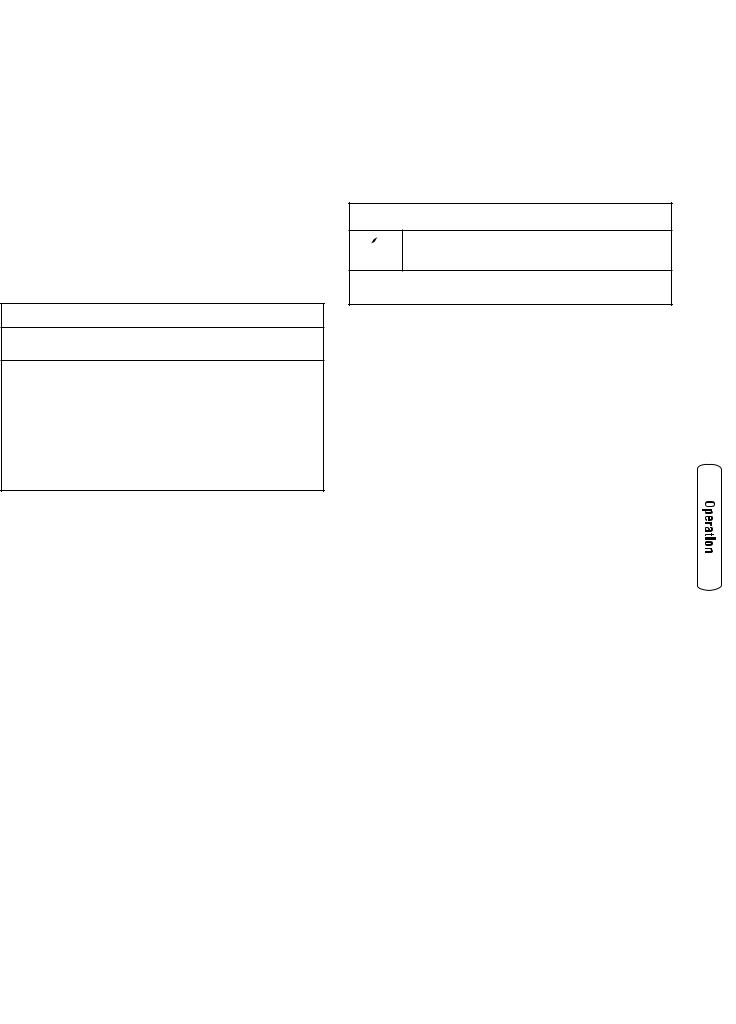
Connecting Electrical Loads
1.Let engine stabilize and warm up for a few minutes after starting.
2.Plug in and turn on the desired 120/240 Volt AC, single phase, 60 Hz electrical loads.
NOTE:
•DO NOT connect 240 Volt loads to the 120 Volt duplex receptacles.
•DO NOT connect 3-phase loads to the generator.
•DO NOT connect 50 Hz loads to the generator.
•DO NOT OVERLOAD THE GENERATOR. See Don’t Overload Generator.
NOTICE
Exceeding generators wattage/amperage capacity can damage generator and/or electrical devices connected to it.
•DO NOT exceed the generator’s wattage/amperage capacity. See
Don’t Overload Generator in the Operation section.
•Start generator and let engine stabilize before connecting electrical loads.
•Connect electrical loads in OFF position, then turn ON for operation.
•Turn electrical loads OFF and disconnect from generator before stopping generator.
Stopping the Engine
1.Turn OFF and unplug all electrical loads from generator panel receptacles. NEVER start or stop engine with electrical devices plugged in and turned ON.
2.Let engine run at no-load for several minutes to stabilize internal temperatures of engine and generator.
3.Push engine rocker switch to “Off” position.
 WARNING
WARNING
 Backfire, fire or engine damage could occur.
Backfire, fire or engine damage could occur.
•DO NOT stop engine by moving choke control to “Choke” position.
4.Move fuel valve to “Off” position.
13

Don’t Overload Generator
Capacity
You must make sure your generator can supply enough rated (running) and surge (starting) watts for the items you will power at the same time. Follow these simple steps:
1.Select the items you will power at the same time.
2.Total the rated (running) watts of these items. This is the amount of power your generator must produce to keep your items running. See Wattage Reference Guide.
3.Estimate how many surge (starting) watts you will need. Surge wattage is the short burst of power needed to start electric motor-driven tools or appliances such as a circular saw or refrigerator. Because not all motors start at the same time, total surge watts can be estimated by adding only the item(s) with the highest additional surge watts to the total rated watts from step 2.
Example: |
|
|
|
|
Rated (Running) |
|
Additional Surge |
|
|
||
Tool or Appliance |
Watts |
|
(Starting) Watts |
Window Air |
1200 |
|
1800 |
Conditioner |
|
|
|
Refrigerator |
800 |
|
1600 |
|
|
|
|
Deep Freezer |
500 |
|
500 |
Television |
500 |
|
— |
|
|
|
|
Light (75 Watts) |
75 |
|
— |
|
|
|
|
|
3075 Total |
|
1800 Highest |
|
Running Watts |
|
Surge Watts |
Total Rated (Running) Watts |
= 3075 |
||
Highest Additional Surge Watts |
= 1800 |
||
Total Generator Output Required |
= 4875 |
||
Power Management
To prolong the life of your generator and attached devices, it is important to take care when adding electrical loads to your generator. There should be nothing connected to the generator outlets before starting its engine. The correct and safe way to manage generator power is to sequentially add loads as follows:
1.With nothing connected to the generator, start the engine as described in this manual.
2.Plug in and turn on the first load, preferably the largest load you have.
3.Permit the generator output to stabilize (engine runs smoothly and attached device operates properly).
4.Plug in and turn on the next load.
5.Again, permit the generator to stabilize.
6.Repeat steps 4 and 5 for each additional load.
NEVER add more loads than the generator capacity. Take special care to consider surge loads in generator capacity, as described above.
Wattage Reference Guide
|
Rated* |
Additional |
Tool or Appliance |
(Running) |
Surge |
|
Watts |
(Starting) |
|
|
Watts |
|
|
|
Essentials |
|
|
|
|
|
Light Bulb - 75 watt |
75 |
— |
|
|
|
Deep Freezer |
500 |
500 |
Sump Pump |
800 |
1200 |
|
|
|
Refrigerator/Freezer - 18 cf |
800 |
1600 |
|
|
|
Water Well Pump - 1/3 hp |
1000 |
2000 |
Heating/Cooling |
|
|
|
|
|
Window AC - 10,000 BTU |
1200 |
1800 |
|
|
|
Window Fan |
300 |
600 |
Furnace Fan Blower - 1/2 hp |
800 |
1300 |
|
|
|
Kitchen |
|
|
|
|
|
Microwave Oven - 1000 Watt |
1000 |
— |
Coffee Maker |
1500 |
— |
|
|
|
Electric Stove - Single Element |
1500 |
— |
|
|
|
Hot Plate |
2500 |
— |
Family Room |
|
|
|
|
|
DVD/CD Player |
100 |
— |
|
|
|
VCR |
100 |
— |
Stereo Receiver |
450 |
— |
|
|
|
Color Television - 27 in |
500 |
— |
|
|
|
Personal Computer w/17 in |
800 |
— |
monitor |
|
|
|
|
|
Other |
|
|
|
|
|
Security System |
180 |
— |
|
|
|
AM/FM Clock Radio |
300 |
— |
Garage Door Opener - 1/2 hp |
480 |
520 |
|
|
|
Electric Water Heater - 40 gallon |
4000 |
— |
|
|
|
DIY/Job Site |
|
|
Quartz Halogen Work Light |
1000 |
— |
|
|
|
Airless Sprayer - 1/3 hp |
600 |
1200 |
|
|
|
Reciprocating Saw |
960 |
960 |
Electric Drill - 1/2 hp |
1000 |
1000 |
|
|
|
Circular Saw - 7-1/4 in |
1500 |
1500 |
|
|
|
Miter Saw - 10 in |
1800 |
1800 |
Table Planer - 6 in |
1800 |
1800 |
|
|
|
Table Saw/Radial Arm Saw - 10 in |
2000 |
2000 |
|
|
|
Air Compressor - 1-1/2 hp |
2500 |
2500 |
* Wattages listed are approximate only. Check tool or appliance for actual wattage.
14 |
BRIGGSandSTRATTON.COM |
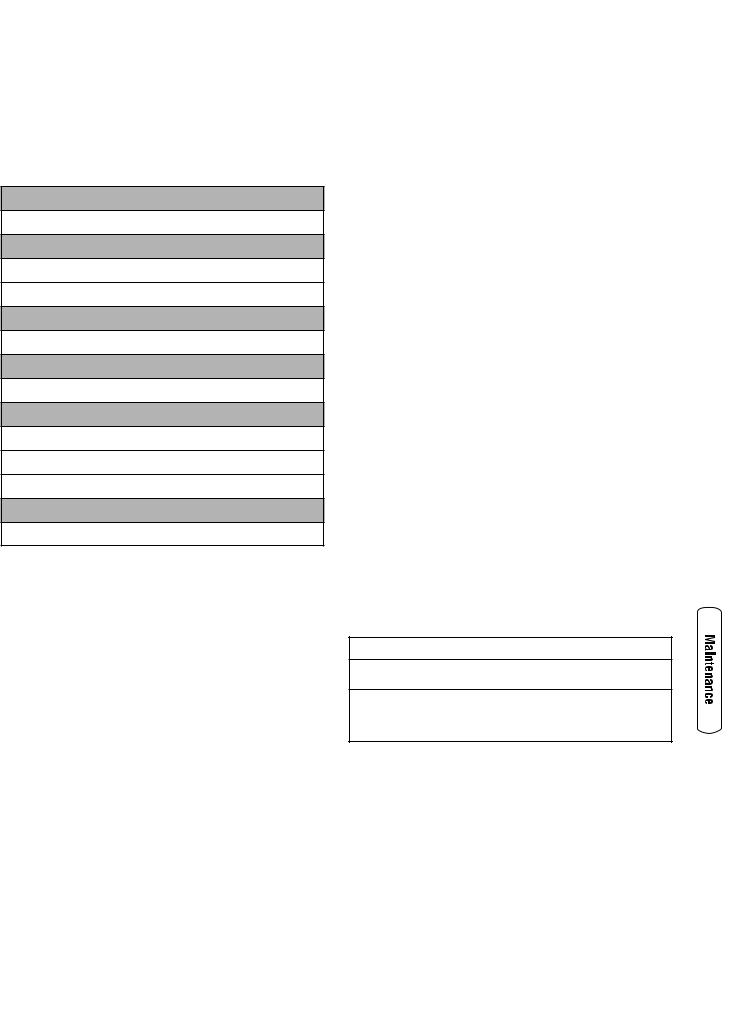
Maintenance
Maintenance Schedule
Follow the hourly or calendar intervals, whichever occurs first. More frequent service is required when operating in adverse conditions noted below.
First 5 Hours
• Change engine oil
Every 8 Hours or Daily
•Clean debris
•Check engine oil level
Every 25 Hours or Yearly
• Service engine air cleaner1
Every 50 Hours or Yearly
• Change engine oil1
Every 100 Hours or Yearly
•Service spark plug
•Service spark arrester
•Clean cooling system1
Every 250 Hours or Yearly
• Check valve clearance
1 Service more often under dirty or dusty conditions.
General Recommendations
Regular maintenance will improve the performance and extend the life of the generator. See an authorized Briggs & Stratton dealer for service.
The generator’s warranty does not cover items that have been subjected to operator abuse or negligence. To receive full value from the warranty, the operator must maintain the generator as instructed in this manual.
Some adjustments will need to be made periodically to properly maintain your generator.
All service and adjustments should be made at least once each season. Follow the requirements in the Maintenance Schedule chart above.
NOTE: Once a year you should clean or replace the spark plug and replace the air filter. A new spark plug and clean air filter assure proper fuel-air mixture and help your engine run better and last longer.
Emissions Control
Maintenance, replacement, or repair of the emissions control devices and systems may be performed by any non-road engine repair establishment or individual.
However, to obtain ”no charge” emissions control service, the work must be performed by a factory authorized dealer. See the Emissions Warranty.
Generator Maintenance
Generator maintenance consists of keeping the unit clean and dry. Operate and store the unit in a clean dry environment where it will not be exposed to excessive dust, dirt, moisture, or any corrosive vapors. Cooling air slots in the generator must not become clogged with snow, leaves, or any other foreign material.
NOTE: DO NOT use water or other liquids to clean generator. Liquids can enter engine fuel system, causing poor performance and/or failure to occur. In addition, if liquid enters generator through cooling air slots, some of the liquid will be retained in voids and cracks of the rotor and stator winding insulation. Liquid and dirt buildup on the generator internal windings will eventually decrease the insulation resistance of these windings.
Cleaning
Daily or before use, look around and underneath the generator for signs of oil or fuel leaks. Clean accumulated debris from inside and outside the generator. Keep the linkage, spring and other engine controls clean. Inspect cooling air slots and openings on generator. These openings must be kept clean and unobstructed.
Engine parts should be kept clean to reduce the risk of overheating and ignition of accumulated debris:
• Use a damp cloth to wipe exterior surfaces clean.
NOTICE
Improper treatment of generator can damage it and shorten its life.
•DO NOT expose generator to excessive moisture, dust, dirt, or corrosive vapors.
•DO NOT insert any objects through cooling slots.
•Use a soft bristle brush to loosen caked on dirt or oil.
•Use a vacuum cleaner to pick up loose dirt and debris.
15
